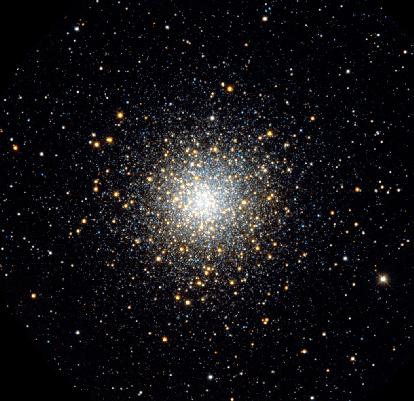The (Anisotropic) Gaseous Model "SPEDI" |
|---|
"SPEDI" denotes an efficient numerical code and physical method to describe the secular (relaxation driven) evolution of spherical dense star clusters (globulars, young massive star clusters). "SPEDI" (sometimes also more technically denoted as AGM = "A"nisotropic "G"aseous "M"odel) is maintained at Astronomisches Rechen-Institut (member of RSDN - The Rhine Stellar Dynamics Network ); the name occurred since its present version originated from a research stay of Rainer "SP"urzem at the University of "EDI"nburgh with Douglas Heggie in 1993. However, its origins go back to V.A. Antonov, D. Sugimoto, D. Lynden-Bell, E. Bettwieser (see more details in History). Important detections have been made with the gaseous model in the past such as gravothermal oscillations (Bettwieser & Sugimoto 1984) and concepts of gravothermal instability have been coined with its notions (Antonov 1962, Lynden-Bell & Wood 1968), and it is presently the only model able to follow very large star cluster with many binaries (Giersz & Spurzem 2003, see stochastic hybrid model).

* Antonov, V.A.: 1962, Vest. Leningrad Gos. Univ., 7, 135,
translated in ``Dynamics of Star Clusters'', IAU-Symp. No. 113,
1985, eds. J. Goodman and P. Hut, Dordrecht, Reidel, p. 525.
* Lynden-Bell, D.; Wood, R., 1968, MNRAS, 138, 495
The gravo-thermal catastrophe in isothermal
spheres and the onset of red-giant structure for stellar systems
* Larson, R. B., 1970, MNRAS, 147, 323
A method for computing the evolution of star clusters
* Hachisu, I.; Sugimoto, D., 1978, Prog. Theor. Phys. 60, 123
Gravothermal Catastrophe and Negative Specific Heat of Self-Gravitating Systems
* Louis, P. D., 1990, MNRAS, 244, 478
An anisotropic homological model for core collapse in star clusters
* Louis, P. D., Spurzem, R., 1991, MNRAS, 251, 408
Anisotropic gaseous models for the evolution of star clusters
* Spurzem, R., 1996, in Hut, P., Makino, J., eds, Proc. IAU Symp. 174, Dynamical Evolution of star clusters, p. 111
Fluid techniques and evolution of anisotropy
* Spurzem, R., Giersz, M., 1996, MNRAS, 283, 805
A stochastic Monte-Carlo approach to model real star cluster evolution.
I. The model
* Hachisu, I.; Nakada, Y.; Nomoto, K.; Sugimoto, D., 1978, Prog. Theor. Phys. 60, 393
Gravothermal Catastrophe of Finite Amplitude
* Bettwieser, E., Spurzem, R., 1986, A&A, 161, 102
Anisotropy in stellar dynamics
* Bettwieser, E., Sugimoto, D., 1984, MNRAS, 208, 493
Post-collapse evolution and gravothermal oscillation of globular clusters
* Heggie, D. C., 1984, MNRAS, 206, 179
Post-collapse evolution of a gaseous cluster model
* Heggie, D. C., Ramamani, N., 1989, MNRAS, 237, 757
Evolution of star clusters after core collapse
* Lynden-Bell, D., Eggleton, P. P., 1980, MNRAS, 191, 483
On the consequences of the gravothermal catastrophe
* Sugimoto, D., Bettwieser E., 1983 MNRAS, 204, 19P
Post-collapse evolution of globular clusters
* Amaro-Seoane, P.; Freitag, M.; Spurzem, R., 2004, MNRAS, 352, 655
Accretion of stars on to a massive black hole:
a realistic diffusion model and numerical studies
* Gürkan, M. Atakan; Freitag, Marc; Rasio, Frederic A., 2004, ApJ, 604, 632
Formation of Massive Black Holes in Dense Star Clusters.
I. Mass Segregation and Core Collapse
* Boily, C. M.; Lançon, A.; Deiters, S.; Heggie, D. C.,, 2005, ApJ, 620, 27
The M/L* Ratio of Young Star Clusters in Galactic Mergers
* Giersz, M., Spurzem, R., 2003, MNRAS, 343, 781
A stochastic Monte Carlo approach to modelling real star cluster evolution
III. Direct integration of three- and four-body interactions
* Bettwieser E., Sugimoto, D., 1985, MNRAS, 212, 189
Gravitational N-body problem and the validity of concepts of the gas model
* Giersz, M., Spurzem, R., 1994, MNRAS, 269, 241
A comparison of direct N-body integration with anisotropic gaseous models of star clusters
* Giersz, M., Spurzem, R., 2000, MNRAS, 317, 581
A stochastic Monte Carlo approach to model real star cluster evolution
II. Self-consistent models and primordial binaries
* Spurzem, R., Takahashi, K., 1995, MNRAS, 272, 772
Comparison between Fokker-Planck and gaseous models of star clusters in the multi-mass case revisited
* Spurzem, R., Aarseth S.J., 1996, MNRAS, 282, 19
Direct collisional simulation of 10000 particles past core collapse
* Spurzem, R., Giersz, M., Takahashi, K., Ernst, A., 2005, MNRAS subm.,
astro-ph/0412698
Tidally limited star clusters -- comparing gaseous models with other techniques
Back to the Home Page of the Astronomisches Rechen-Institut
Updated: May 2005 spurzem@ari.uni-heidelberg.de